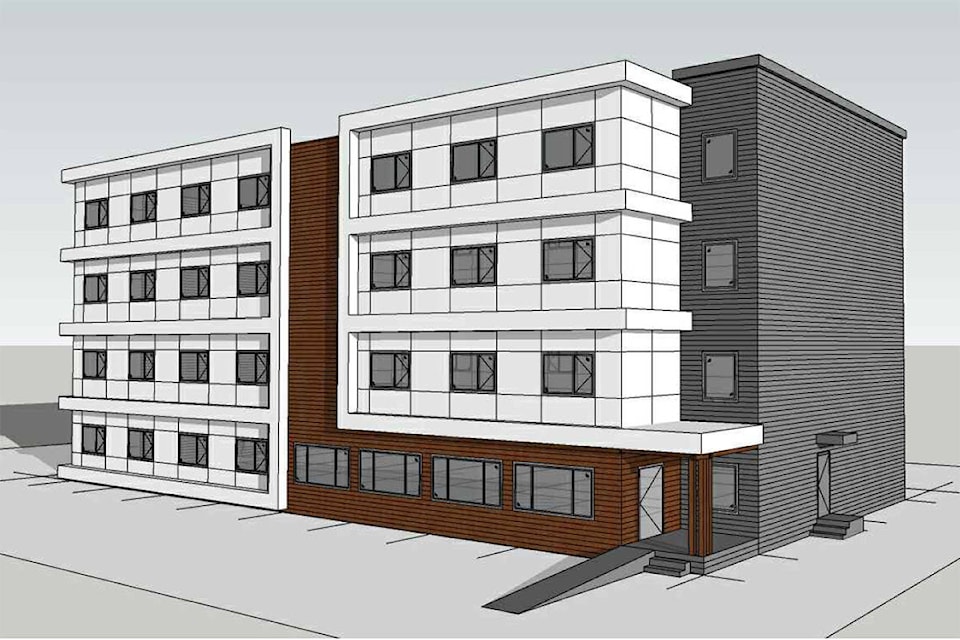Vancouver won’t be shipping people from its streets into the supportive housing proposed in Hope, BC Housing told a packed council chambers on Monday night.
“Vancouver just built 600 units,” said Naomi Brunemeyer, development director for BC Housing. “They are not going to send their homeless to Hope when you have 52 (units). These are for your people, that are here. This is to be a solution that is specific to your community.”
Brunemeyer was speaking to council following a consultation period BC Housing held in the community. That included an opportunity to email concerns and comments to BC Housing, and take part in two open houses held late last year in Hope.
BC Housing has partnered with Hope and Area Transition Society (HATS) to bring a 52-unit supportive housing project to Hope, as an addition to the current House of Hope homeless shelter. The housing would be built at 660/670 Old Hope Princeton Way.
On Monday night, Brunemeyer underlined the need for this kind of housing in Hope and who would be living there if it goes through.
“They are residents of Hope that are being prioritized,” she said. “I want that to be really clear.”
Hope’s small council chambers was filled to standing room only, with some people believing they would have a chance to air their concerns about the proposed project. But Mayor Peter Robb made it clear at the beginning of the meeting that this was a delegation only, and no voting was taking place.
“This meeting tonight is not a public hearing,” he said at the top of the meeting. “A lot of misinformation has gotten out there, because this a big crowd tonight. We’re not voting on anything, nothing’s moving forward and no zoning application has come in.”
He said that when the zoning application comes in, there will be a public meeting in a larger facility and there will be plenty of notice to the community. The zoning application would also bring the House of Hope into compliance with the Official Community Plan if approved.
But nothing is at that stage yet. Monday’s presentation was just to outline the community concerns — and praise — they heard during the consultation period, and update council on the project. They found that a main concern by residents is that more people with homelessness and addictions issues would be sent to Hope because of the housing.
Brunemeyer’s presentation included a homelessness count on Jan. 10, 2020 and found that 28 people were living outside in homeless camps. Another 31 were staying in emergency weather shelter beds at the House of Hope, and another 45 people are living in precarious housing. That means they are couch-surfing, living in vehicles, in a motel or are pending eviction.
Of those 104 people counted, 55 people identified themselves as local — either born in Hope, with family in Hope, or as long-term residents. The House of Hope provides sleeping accommodations to 20 people year round, but they have to leave in the daytime. In extreme weather between November and March, another 16 mats are brought out.
From all the comments received during the open houses, emails and website for the project, there were 85 people who engaged with BC Housing. The majority of those were in support of the project, at 42 per cent, while 35 per cent were in opposition. Another 23 per cent more were undecided or neutral.
BC Housing is hoping to quell concerns in the community in the hopes that the project will go through.
“Without this housing option, people will continue to live without access to safe, stable homes, often with deteriorating health,” the executive summary for the presentation states. “There is need in Hope, for people who are from Hope — the data enclosed, and the experience of local outreach workers supports this.”
Brunemeyer noted that not all people who are living this way want to be housed, or are even eligible to be housed.
“There are people who are not ready to come into housing, what we’re talking about is permanent, supportive housing,” she said.
Some residents have also said they would support the project if it were smaller, or if it weren’t a “wet” facility, where people are allowed to have addictions and consume drugs or alcohol in their units. But low-barrier access is what BC Housing says is the key to success of supportive housing projects.
Residents have around-the-clock access to assistance, and despite their addictions are expected to follow certain rules and meet criteria to keep their housing. But they also have the autonomy and privacy of someone renting in the private sector.
Brunemeyer said they have been working with HATS for years in finding the right property for such a project, as the housing problem in Hope continued to grow. She said the location they’ve chosen is “gold star standard” in BC Housing’s eyes.
READ MORE: Proposal for supportive housing decision now rests with Hope council
Do you have something to add to this story, or something else we should report on? Email:
news@hopestandard.com
@CHWKcommunity
Like us on Facebook and follow us on Twitter.
